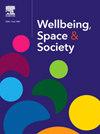Mental health in the Ruhr – Links between a neighborhood's characteristics and depression
IF 2.2
Q2 GEOGRAPHY
引用次数: 0
Abstract
Few empirical studies have examined the impact of neighborhood context on mental health while controlling for various relevant factors. This paper addresses this gap by analyzing data from the Heinz Nixdorf Multigenerational Study (N = 2,897, age range = 18–90 years) of residents in Mülheim an der Ruhr, Essen, and Bochum (Germany) from 2013 to 2016. Using cluster-robust logistic regression, we investigated how neighborhood factors influence the likelihood of depression, accounting for individual-level characteristics.
The findings indicate that high urbanization, perceived lack of nighttime safety, and especially neighborhood socio-economic disadvantage significantly increase the risk of depression, especially when considering length of residence. These results highlight the significant impact of socially disadvantaged neighborhoods on mental health, underscoring the need for targeted interventions to prevent extreme socio-spatial segregation.
鲁尔地区的心理健康——社区特征与抑郁症之间的联系
在控制各种相关因素的情况下,很少有实证研究考察邻里环境对心理健康的影响。本文通过分析Heinz Nixdorf多代研究(N = 2,897,年龄范围= 18-90岁)的数据来解决这一差距,这些数据来自2013年至2016年德国姆海姆和下鲁尔,埃森和波鸿的居民。利用聚类稳健性逻辑回归,我们研究了社区因素如何影响抑郁的可能性,并考虑了个人水平的特征。研究结果表明,高度城市化,缺乏夜间安全,特别是社区社会经济劣势显著增加了抑郁症的风险,特别是考虑到居住时间的长短。这些结果突出了社会弱势社区对心理健康的重大影响,强调需要采取有针对性的干预措施,以防止极端的社会空间隔离。
本文章由计算机程序翻译,如有差异,请以英文原文为准。
求助全文
约1分钟内获得全文
求助全文
来源期刊

Wellbeing Space and Society
Social Sciences-Social Sciences (miscellaneous)
CiteScore
2.70
自引率
0.00%
发文量
46
审稿时长
124 days
 求助内容:
求助内容: 应助结果提醒方式:
应助结果提醒方式:


